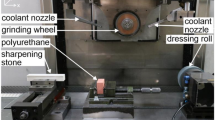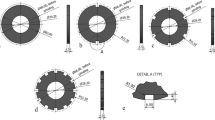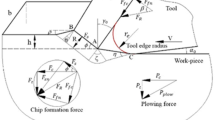Abstract
An appropriated cutting edge geometry can highly contribute to the cutting tools performance and lifetime. But although today many technologies for cutting edge preparation are known each one requires extra equipment and extensive experience in application. The presented technology of manufacturing rounded cutting edges with elastic bonded grinding wheels inside the tool grinding machine deals with those disadvantages. In this context the influence of machining conditions such as cutting speed, feed rate and depth of cut when manufacturing rounded cutting edges with elastic bonded grinding wheels on the size of the resulting cutting edge will be investigated. Additionally the effects of changing the grinding wheel contact condition as well as the grinding strategy on the shape of the resulting cutting edge were analyzed. It will be shown that the machining conditions are suitable to adjust the properties of the rounded cutting edge regarding size and shape.











Similar content being viewed by others
References
Bouzakis KD, Bouzakis E, Kombogiannis S, Makrimallakis S, Skordaris G, Michailidis N, Charalampous P, Paraskevopoulou R, M’Saoubi R, Aurich JC, Barthelmä F, Biermann D, Denkena B, Dimitrov D, Engin S, Karpuschewski B, Klocke F, Özel T, Poulachon G, Rech J, Schulze V, Settineri L, Srivastava A, Wegener K, Uhlmann E, Zeman P (2014) Effect of cutting edge preparation of coated tools on their performance in milling various materials. CIRP J Manuf Sci Technol 7:264–273. doi:10.1016/j.cirpj.2014.05.003
Basset E (2014) Belastungsspezifische Auslegung und Herstellung von Schneidkanten für Drehwerkzeuge. Ph.D. thesis, Gottfried Wilhelm Leibnitz University Hannover
Aurich JC, Zimmermann M, Leitz L (2011) The preparation of cutting edges using a marking laser. Prod Eng Res Dev 5:17–24. doi:10.1007/s11740-010-0275-9
Denkena B, Biermann D (2014) Cutting edge geometries. CIRP Ann Manuf Technol 63:631–653. doi:10.1016/j.cirp.2014.05.009
Denkena B, Köhler J, Breidenstein B, Abrãoa AM, Ventur CEH (2014) Influence of the cutting edge preparation method on characteristics and performance of PVD coated carbide inserts in hard turning. Surf Coat Technol 254:447–454. doi:10.1016/j.surfcoat.2014.07.003
Heymann T (2012) Gezielte Nut- und Schneidkantenpräparation von Vollhartmetall-Zerspanwerkzeugen durch Polierschleifen. In: Biermann D (ed) Spanende Fertigung, 6th edn. Vulkan Verlag, Essen, pp 104–110
Brodbeck J, Rothenaicher S, Biermann D et al (2014) Mit elastisch gebundenen Scheiben die Kanten verrunden. Werkstatt Betrieb 1–2:84–87
Effgen C, Kirsch B (2013) A new method for the preparation of cutting edges via grinding. Adv Mater Res 769:85–92. doi:10.4028/www.scientific.net/AMR.769.85
Effgen C, Kirsch B, Aurich JC (2013) Schneidkantenpräparation mithilfe elastisch gebundener Schleifscheiben. VDI-Z II Spezial Werkzeuge August:22–24
Effgen C (2013) Ein neues Verfahren zur Schneidkantenpräparation mittels Schleifen. 4th European Conference on Grinding 16-4-1:16-4-9
Biermann D, Wolf M, Aßmuth R, Kipp M (2013) Der letzte Schliff formt die Mikrogestalt. Forum Schneidwerkzeug- und Schleiftechnik 26(2):76–83
Denkena B, Luca A, Basset E (2011) Effects of the cutting edge microgeometry on tool wear and its thermomechanical load. CIRP Ann Manuf Technol 60:73–76. doi:10.1016/j.cirp.2011.03.098
Denkena B, Reichenstein M, Brodehl J, Garcia de Leon L (2005) Surface preparation, coating and wear performance of geometrically defined cutting edges. In: Proceedings of the 5th international conference the coatings in manufacturing engineering, 5–7; October 2005
Karpuschewski B, Schmidt K, Beňo J, Maňkováb I, Prilukovac J (2014) Measuring procedures of cutting edge preparation when hard turning with coated ceramics tool inserts. Measurement 55:627–640. doi:10.1016/j.measurement.2014.06.008
Brinksmeier E, Heinzel C, Bleil N (2009) Superfinishing and grind-strengthening with elastic bonding system. J Mater Process Technol 209:6117–6123. doi:10.1016/j.jmatprotec.2009.08.027
Heinzel C, Wagner A (2013) Fine finishing of gears with high shape accuracy. CIRP Ann Manuf Technol 62:359–362. doi:10.1016/j.cirp.2013.03.070
N.N. (2013) Manual: optical 3D measurement device for cutting tools, version 4.7 rev. 1. GFMesstechnik GmbH, Berlin
Acknowledgments
This research was funded by the European regional development fund (EFRE) within the regional competitiveness and employment program of Rhineland-Palatinate 964-52708-1/81036914 “Cutting edge preparation with dressable grinding wheels”. Additional partners are the Lapport Schleiftechnik GmbH, Enkenbach, Germany and the K.-H. Müller Präzisionswerkzeuge GmbH, Sien, Germany.

Author information
Authors and Affiliations
Corresponding author
Rights and permissions
About this article
Cite this article
Aurich, J.C., Effgen, C. Influence of the machining conditions when preparing cutting edges with elastic bonded grinding wheels. Prod. Eng. Res. Devel. 9, 329–336 (2015). https://doi.org/10.1007/s11740-015-0622-y
Received:
Accepted:
Published:
Issue Date:
DOI: https://doi.org/10.1007/s11740-015-0622-y




